This book provides an illustrated record of historical trains and locomotives on railways around the world, starting in Africa and progressing through the other continents to finish in the Middle East.
Published in October 2023 by Amberley Publishing and written by Alon Siton, this soft cover book measures around 23.4 cm x 16.5 cm, and has 96 pages and 180 illustrations. It has a published price of £15.99 although Amberley Publishing currently has it on offer at £14.39, and at the time of writing, it can be obtained from Amazon for £12.29.
This book is a portfolio illustrating railways around the world, mainly before the 1960s. Although the word “Railways” in the book’s title conjures up images of trains in their working environment, many of the photographs are of locomotives with no reference to the actual railways on which they worked.
Many of the photographs in this book are of special interest as they show railways that are no longer in existence or locomotives that look totally unfamiliar. A selection of maps and historical posters add to the historical theme, although at the reproduction size used in the book the legibility of the maps is very poor. Also, in the Middle East section, German language maps have been used.
The images are grouped by continent starting with Africa. However, instead of following a geographical journey around the world, Africa is followed by North America, South America, Australia and New Zealand, Europe, and finally the Middle East. A great omission is that the book is not sub-divided into sections, and neither is there is an Index nor Contents List.
The book’s Introduction mentions the Ottoman Empire’s Hedjaz Railway, the Berlin-Baghdad railway, and the Cape to Cairo railways, but the only evidence of these lines is on the barely legible maps. Similarly, the Introduction mentions the joy of pulling into Baghdad station travelling from northern Egypt, to Luxor, in a fancy Wagons Lits coach. There are also some surprising omissions which are to be expected in a book of the World’s historical railways, such as the Trans-Siberian Railway or the transcontinental lines of the USA.
The pages below are typical of the book’s content, with extensive captions that concentrate more on the locomotives than on the railways on which they ran. Several maps are included, but most are, such as the one on the right, more topographical rather than a depiction of railway lines.
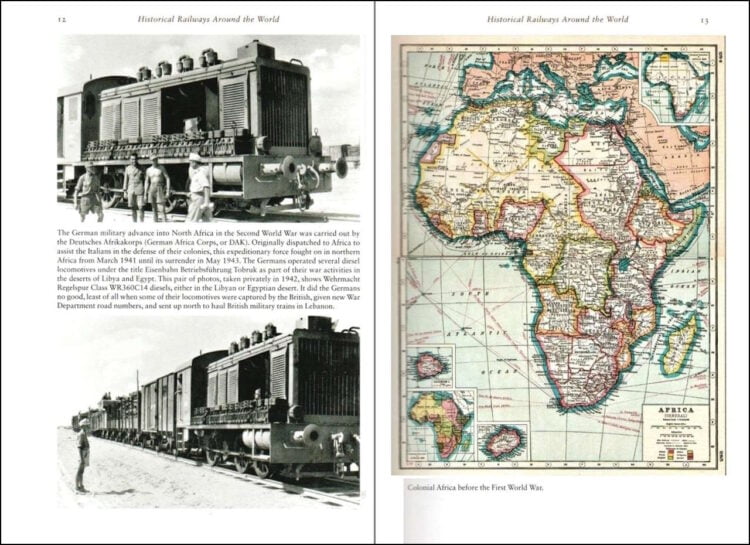
Whilst the book has 28 pages dedicated to railways in Africa, the pages below are the only entry from North America with the right-hand page showing single photographs of a Canadian and a US railway, while half of the left-hand page is taken up with an African theme. It would have been useful if some distinction could have been made when different continents are introduced, such as here, as throughout the book the headings on both left and right pages simply repeat the book’s title instead of a more useful section title.
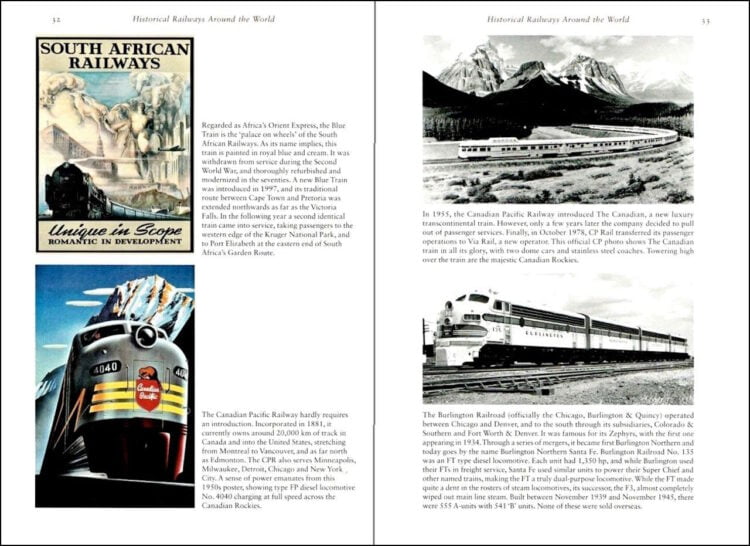
South America fares rather better than North America, with five pages but not a single map and most photographs showing locomotives in isolation rather than the railways on which they operated.
An exception is the right-hand page which shows a train working, but frustratingly, the caption is on the following page. However, the caption concentrates mainly on the locomotive itself, and the only information on the railway is that it is one of two built by the Anglo-Chilean Nitrate & Railway Company, and the reader is left to assume that it is somewhere in Chile.
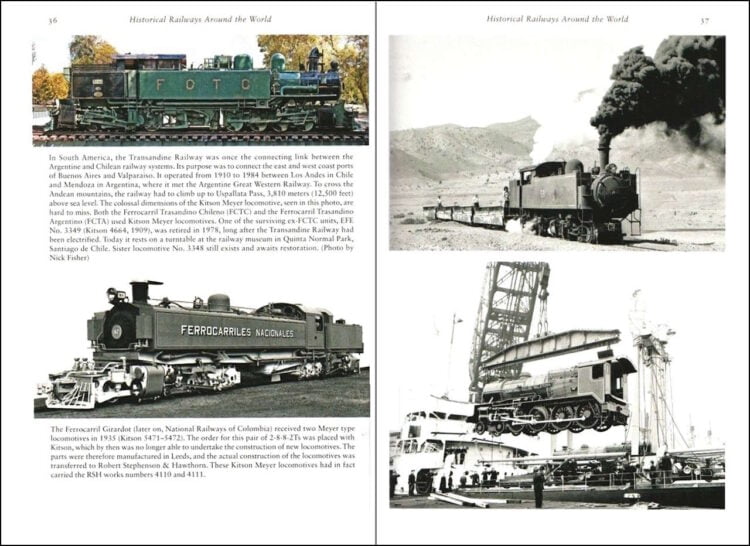
There are five pages covering Australasia, but significantly no mention of the continent’s most famous train, The Ghan which originally ran from Adelaide to Alice Springs but now continues to Darwin.
The section includes a reproduction of a poster advertising the Trans-Australian Railway but the supporting caption fails to mention that it has the world’s longest stretch of dead-straight track, the 297 miles across the Nullarbor Plain. New Zealand creeps into the book by virtue of the photo at the bottom right, but rather than of a historic railway it is a restored tram on a tramway that opened in 1968.
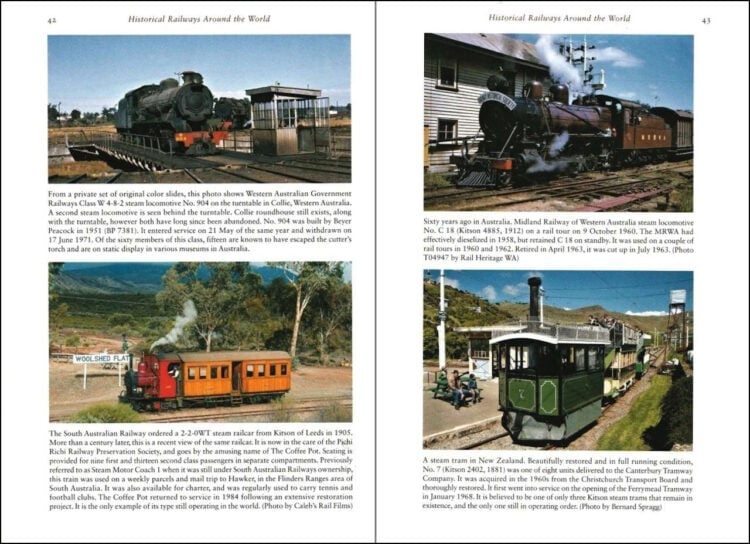
The European section has 13 pages but only includes contributions on French, German, and British railways. There is no mention of Germany‘s most famous train, “The Flying Hamburger”, or the suspended railway in Wuppertal, the Wuppertaler Schwebebahn.
An excessive five pages are devoted to Britain’s “Flying Scotsman” but there is no mention of the equally-famous and longer-running “Cornish Riviera Express”. The photograph at the bottom right shows the historic locomotive Lambton No.29 working on the North Yorkshire Moors Railways, but the book fails to include anything about the world’s most famous historic railway, the Stockton & Darling Railway, or the equally famous locomotives Rocket, Locomotion No. 1 or Puffing Billy.
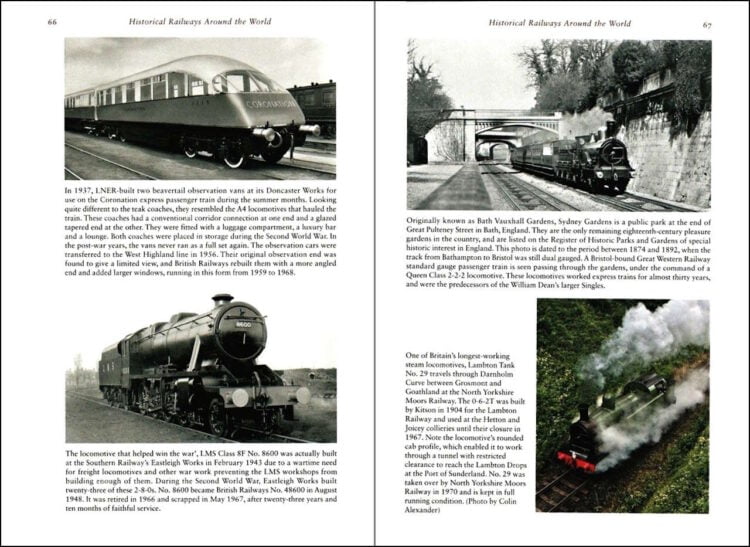
Although the word “Railways” in the book’s title conjures up images of trains in their working environment, many of the photographs are of locomotives with no reference to the actual railways on which they worked.
The images are grouped by continent starting with Africa, but subsequent continents are included in an illogical order as Africa is followed by North America, South America, Australia and New Zealand, Europe, and finally the Middle East. The lack of an Index or Contents List is surprising.
Most of the maps are too small to be legible, and while the Africa section has five maps, there are none for North or South America or Australasia, and just a single map for the whole of Europe that covers all of the continent and is illegible. The final section covers the Middle East and has three maps, but strangely these are all in German.
Some of the railways mentioned in the Introduction only appear on the barely legible maps, whilst the description of pulling into Baghdad station becomes a photo of Cairo station in Egypt.
Many readers will be disappointed with the notable omissions, such as no mention of the Trans-Siberian Railway or the transcontinental lines of the USA, and my general impression of the book is that it concentrates on too few of the world’s many historical railways,
The book is available to purchase from Amazon and from Amberley Publishing.
We would like to thank Amberley Publishing for providing us with a copy of the book for review.






Responses